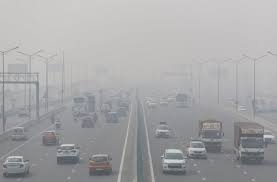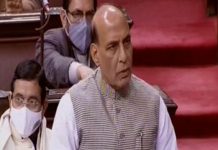The poor air quality in Northern India has evolved from ‘bad air days’ to an annual ‘airpocalypse,’ becoming the region’s biggest public health crisis. The rising pollution is now causing lasting ophthalmic and pulmonary ailments, threatening life expectancy. A report by Aayush Goel

It’s that time of year again. The festivities have given way to a hazy November. North India and the Indo-Gigantic plains are out battling the perennial smog. Graduating from ‘bad air days’ to annual ‘aerpoclypse,’ the poor air quality is emerging as the biggest public health crisis in Northern India which from causing temporary illness is now converting into permanent ophthalmic, and pulmonary ailment and attacking the life expectancy, especially amongst children. Delhi, which is worst impacted, has already instituted special ‘Pollution’ Out Patient Departments (OPDs) in hospitals. Over the last decade, the problem has only grown more serious, with newer studies presenting deadlier statistics.
It found that one out of every eight deaths in India were attributable to air pollution and the average life expectancy in the country would have been 1.7 years higher if the air pollution level was less than the minimal level causing health loss. The average life expectancy of those living in the Indo-Gangetic Plain (IGP) is seven years shorter than those in other regions in India as found in an analysis of the Air Quality Life Index (AQLI) by the Energy Policy Institute at the University of Chicago (EPIC).
Air pollution soared 72 percent from 1998 to 2016 in these northern plains where 40 percent of India’s population live. The level didn’t meet the World Health Organization’s (WHO) guideline for fine particulate pollution. In 1998, the impact on people’s lives would have been half of what it is today, with residents losing an average of 3.7 years in life expectancy. The states and Union Territories affected by higher pollution include Chandigarh, Delhi, Haryana, Punjab, Uttar Pradesh, Bihar and West Bengal.
In 2019, India launched its National Clean Air Programme (NCAP). The programme aimed to reduce particulate pollution by 20-30 percent nationally and set goals for the next five years. However, the country has visibly failed to meet its goals.
Stubble Burning Key culprit
The first and foremost culprit is the paddy stubble being burnt by farmers in states like Punjab, Haryana and (western) Uttar Pradesh. The stubble has to be removed so that the fields can be prepared for growing wheat, a legacy of the Green Revolution which made the paddy-wheat cycle the norm across much of the north Indian plains.
Since burning is the easiest way to remove stubble, farmers do that. Over the past decade, several schemes have been launched by the government to wean farmers away from the paddy-wheat cycle, quicken the harvesting of paddy as well as provide farm implements to ease the removal of stubble. According to a recent report by the Ministry of Environment, the average contribution of stubble burning to the concentration of PM2.5 in Delhi-NCR during the peak phase has increased from 10% in 2019 to over 15% this year with Punjab reporting an increase of 48% in fire incidents while these declined by 28% in Haryana. The analysis has been done based on inputs from the CPCB (Central Pollution Control Board) and institutions of the Ministry of Earth Sciences, which also shows that the number of days observed with more than 10% contribution of stubble-burning to PM 2.5 has increased from 21 days in 2019 to 26 days this year. The maximum contribution of 42% was observed on November 5 this year. Stating that crop residue burning in northwest regions was “one of the sources of air pollution for Delhi-NCR during October-November”, the ministry noted that Punjab during September 21-November 22 period reported a substantial increase of over 46% in its total count of active fire events (AFE) this year compared to the corresponding period in 2019. On the other hand, Haryana almost during the same period (September 25-November 22) reported a decline in cases of stubble-burning by over 28%. It may be noted that not just North India but even Pakistan blames stubble burning in Punjab as CM Bhagwant Mann defends the state saying pollution needs to be dealt with collectively. “There should be no blame game over the pollution issue”, said Mann and stressed that its solution should be found in cooperation with other states. “It is also the problem of Madhya Pradesh, Uttar Pradesh and Haryana. Its solution has to be found by sitting together and promoting crop diversification”, he added.
Punjab, Haryana fail to Act against stubble burning: Supreme Court
The Supreme Court, while hearing an ongoing petition, noted that the governments in Punjab and Haryana remained reluctant to act against farmers who resort to stubble burning in the fields, leading to a rise in air pollution.
A Bench of Justices Abhay S Oka and Augustine George Masihalso asked how the stubble-burning incidents had seen a rise on the day of Diwali recently.
“How can this happen? How come this increased in Diwali? Why are you sparing your officers? They are sparing the farmers. Farmers are filing IA [Intervention Application] before us because they are fearing things. And now you all are sparing your officers,” the Court asked. In the order, the Court said the States must explain the non-prosecution of farmers accused of stubble burning.
“Even today, we find reluctance on the part of governments in taking action under Section 14 of the CAQM Act, 2021. We have observed in earlier orders that instead of direct prosecution, States are still busy in just issuing show-cause notices despite flagrant breaches. States owe an explanation to us on non-prosecution,” it said.
The Court directed strict compliance of the rules in this regard. The Bench was hearing the case concerning pollution in Delhi. It is specifically examining the action taken by authorities across Punjab, Haryana and Uttar Pradesh to curb stubble-burning incidents. In October, the Court had taken a prima facie view that the Union government was not taking any penal action to curb stubble burning. It had directed the authorities to amend the law to increase the fines against stubble burning. Since then, the fines have been increased. The Court questioned the States of Punjab and Haryana for lack of action against the officials who had not properly carried out their duties to enforce the ban on stubble burning.
“Please see – 1,037 erring officials have been sent show cause notice. There has to be due process. Also, we have to look into the present, the past is gone,” the counsel representing Punjab replied.
However, the Court took an exception to the statement. “How can the past be forgotten? Look at the past first. Only 56 officials have been prosecuted. What about else? Nothing has been done by you people on continuous stubble burning,” Justice Oka said.
Then, the Centre told the Court that it had rejected the Punjab government’s demand for funds for tractors and other materials for farmers to tackle stubble burning. “Let Advocate General for Punjab respond to this,” the Court said.
The other key culprits
Many leaders and environmentalists argue that stubble burning cannot be solely held responsible for pollution crises in Delhi NCR. Unchecked rampant construction, construction and demolition waste dumping and dust pollution along with vehicular emissions are cited as other key choking agents. These factors, especially during the colder months when pollutants remain trapped closer to the ground, contribute heavily to the toxic air that residents are forced to breathe. Data from October 12 to 21, 2024 indicated that over half of the city’s PM2.5 pollution comes from vehicles. Delhi’s roads are choked with over one crore registered vehicles and this number continues to grow each year. The city’s public transport system, though extensive, has not kept pace with the expanding population and economic activity, leading to an increased reliance on private vehicles, which worsens the city’s air quality. This is compounded by other local sources, including construction dust, industrial emissions, and the open burning of waste, which further contribute to the city’s high PM2.5 concentrations. “Delhi is doing the best it can to battle pollution. Anti-pollution measures are being strictly deployed in Delhi. We have formed 99 teams who are carrying out dust control measures across Delhi. The government has started the process of deploying more than 325 smog guns. Our key concern is areas bordering UP which have the poorest AQI. We will talk to the UP government as well. The major cause of pollution in Anand Vihar is the buses coming from UP”, says Delhi CM Atishi.












